There’s been a ‘considerable spike’ in shoplifting. What’s causing it? Experts blame legislation, policing policy, austerity, the growth of self-checkouts and even bags for life. But what can be done to tackle it? And how are retailers fighting back?
On 2 March last year a Dublin supermarket had its roof ripped clean off. It was on the day that one of the worst storms in decades struck Ireland, blizzards leaving thousands of homes without power.
But it wasn’t Storm Emma that destroyed the Lidl store. Using the extreme weather to their advantage, burglars used a stolen digger to peel off the supermarket roof before looting food, alcohol and cash. The store had to be demolished.
It’s an extreme example, but it underscores how opportunistic and creative thieves can be and how calamitous are the consequences. And though the severity of the crime meant police officers responded quickly and caught the eight culprits, all too often that’s not the case.
Instances of shoplifting nearly doubled to 950,000 last year, according to the ACS - the equivalent of 200 thefts per hour. It isn’t just small stores either, with data from the BRC revealing a 15% increase in theft across all UK retailers, accounting for more than 70% of the cost of all crime on our high streets (£700m).
The even more alarming statistic here, however, is that the number of arrests for shoplifting have plunged. Home Office figures reveal that during the same five-year period there was a 17% drop in those arrested for shoplifting, and the number charged fell 25%.
So, what’s caused this spike? And what are retailers doing to fight back?
“Police are giving these people more opportunity to steal because they know they won’t end up behind bars”
Many trace the sharp rise back to a change in legislation in 2014, which said anyone stealing goods worth less than £200 would not be pursued by police. Instead, if caught, they could enter a plea via post before facing a fine or custodial sentence. Then in late 2017 London’s Metropolitan police added that they wouldn’t investigate any losses under £50 in value unless a suspect was already identified. The move was taken to help save £400m by 2020 amid swingeing budget cuts, they said.
But at huge cost to the retail sector, some believe. Police crime figures show that from 2013 to 2017 - the years after the change came into force - shoplifting has seen a “considerable spike” of 23%, the only type of common theft to do so, says BRC policy advisor on crime and security James Martin. And the increase could be higher. “There’s some indication that the overall figures are still incomplete,” he adds.
For Paul Cheema, co-owner of Malcolm’s Stores in Coventry, the recent changes in policy have a lot to answer for. “Police just don’t care,” he says. “They’re giving these people more opportunity to go and do it because they know they’re not going to end up behind bars.”
Part of the problem, too, he believes, is the decision to publicise these changes so openly. Only last month, prisons minister Rory Stewart suggested to national newspapers that sentences under six months could be scrapped to ease pressure on prisons. Nearly 98% of those charged with shoplifting in 2017 were given a sentence of less than six months, leaving it disproportionately affected if the changes were to go ahead.
In the same way, the creation of police and crime commissioners in 2012 can be more of a hindrance than a help, says ACS chief executive James Lowman. The role “has some advantages, but they also create problems because they tend to publicise policies, which just makes criminals aware when there’s a lower risk from committing these crimes”.
“The problem with shop theft offences is that they’re not always reported, and when they are reported the response from police is inconsistent at best,” he adds. “There have been several reports of forces having minimum-value thresholds of goods stolen before they’ll respond to an incident, which offenders are aware of.”
How to negotiate with a thief

It’s not just extra cameras and external security cash is going towards. Another area of focus is staff training.
As part of a more deterrent-based approach, David Liddle, CEO of conflict management consultancy TCM Group, believes “powerful customer service techniques” can help cut crime. These include “building a relationship with people when they walk into the shop, such as introducing yourself, letting them know that you’ve acknowledged them coming into the store, and telling them they’re a welcome customer, and offering support”.
Liddle, an expert in dispute negotiation and resolution, has developed a new programme called Rise, or Retailers Investing in a Safer Environment. The theory is that by staff engaging and interacting with customers, theft and violence is less likely as it becomes harder for a customer to disassociate from that member of staff.
The programme was commissioned by the Safer Business Network, a London-based crime prevention group whose members include John Lewis and McDonald’s, as well as independents. The first trial will take place on 14 May. Liddle is also working with the BRC. “We don’t have a silver bullet, but we do offer to help resolve an issue and prevent a situation from deteriorating into a harmful one,” he adds.
It’s no wonder businesses are now apathetic to reporting crime, adds Nick Fisher, founder of facial recognition technology Facewatch (see below). “The worst-case scenario is that thieves read all this information, that the police aren’t coming out for less than £200, which tells them to keep their retail theft frequent and reasonably low value and the chances of getting caught are quite slim.”
The BRC says it is putting pressure on police and crime commissioners to do better and “give retail crime the priority it deserves” says Martin. “We understand the resourcing and prioritisation pressures, but given how central retail is to the economic and social cohesion of pretty much every community in the country, we think theft could be prioritised a bit more.”
That said, should someone be caught, there are a variety of punishments available to the courts. He also believes that, despite the £200 threshold being added to the Anti-Social Behaviour, Crime and Policing Act 2014, it isn’t “something he’s come across in practice”.
In fact, there are still plenty of instances where shoplifters are punished. Last month, a serial shoplifter was jailed for two years after stealing more than £1,000 of goods from six different stores, for example. Another was jailed for 12 weeks in September after attempting to walk out of a branch of Morrisons with 11 bottles of vodka and whiskey in a trolley.
So it’s arguably not only changes in the law that are sparking this surge in theft. Along with the rise of self-scan checkouts, Jonathan James, owner of James Convenience Retail, says that the 5p charge for carrier bags has played its part. Although he agrees with the surcharge, James says “it has made it difficult for the team to see who has or hasn’t purchased items. A lot of people don’t bother with a bag now and carry items out, whereas before you knew a person had paid for items when they had a carrier bag. This is a problem we really didn’t foresee.”
And as shoplifters get savvier and police appear less inclined to act, the financial burden on retailers grows. A staggering £503m is lost to shoplifting every year, says the BRC, and that’s likely to be a “significant underestimate”, adds Martin. Meanwhile in the convenience sector it’s costing small retailers the equivalent of 7p for every transaction, say the ACS, or £193m.
“It is a huge amount of money we’re losing,” says James. “In one store alone, we hit £1,000 worth of loss in one week. This took that store from being profitable to breaking even at best.”
One delivery of fine cheese disappeared from shelves within two hours, he says. “It’s really quite remarkable, as if they were stealing to order. They usually steal items they can move on, such as nappies, coffee and meat.” According to the ACS, the top three products targeted by thieves were meat, cheese and alcohol. But it isn’t only items for sale that are susceptible. Last year, an Asda store in Cambridge was forced to order 100 replacement shopping baskets after a spate of thefts, and a Tesco store in Stornoway was temporarily unable to provide baskets until a new batch arrived after losing around 15 a week.
How one store manager fought back

At the time of speaking to store manager Nick Carolan, the Tesco Extra in central Hull had already had more than 2,000 arrests for shoplifting since the beginning of March last year. This is a record number for the store, but despite this, Carolan has managed to almost halve the amount of shrinkage from £1.1m to around £600k. His rule of thumb? “Protect everything you possibly can.”
Carolan, who won Store Manager of the Year at The Grocer Gold Awards 2018, has implemented a number of preventative measures. One of his tactics is to tag all stock. “We make sure the tags are visible so that customers can see them, which will hopefully deter a lot of opportunistic thieves.”
It’s not just tagging, though. Carolan has also altered the store layout to help prevent shoplifting, which he calls “reducing shrink by design”. “I’ve tried to open the shop out so there are more visible open spaces,” he says, such as through blocking off gaps in the aisles and moving fixtures to allow staff a clearer view.
“We also looked at where [more valuable] products were merchandised and tried to put them in a more prominent position.” For instance, he moved cosmetics from the middle of the aisle to the end where the products could be seen more clearly.
Then there’s what he calls “just being sensible”. “I don’t stack wine or spirits. I’ll put them out on a full modular or on a fully-tagged PoS. I don’t encourage customers to take full cases. You have to balance selling volume with security.”
The security manager has a monthly meeting with police and other security staff in the town too, run by the Hull Business Improvement District, to “build relationships and share intelligence”. Local law enforcement is invited in to “use staff facilities for a cup of coffee” increasing police presence in store.
“It’s a suite of solutions,” says Carolan. “We’ve got to constantly try something else to reduce shrink because shoplifting is never going away.” Maybe not, but his efforts are undoubtedly impressive.
Staff abuse
Though the financial cost of this theft is astounding, many store owners are also concerned about the impact on staff. Reported violence against staff doubled last year to six victims per 1,000 workers, according to BRC figures. It’s no better in small stores. The ACS recorded 13,437 incidents of violence directed at staff in just one year, 39% of which resulted in injury, with a weapon used in 3,690 instances.
“Our research shows that challenging thieves is one of the biggest triggers of abuse in stores, so it’s a real problem for staff who can feel helpless against crime in their store,” says Lowman.
At Iceland 90% of physical violence against staff results from attempts to stop a shoplifter, adds head of security Duncan Miles. And 65% of incidents of verbal abuse (of which there are around 5,000 per year at Iceland alone) arises from dealing with thieves.
“Putting this into context, in the six years to our 30 March 2016 financial year, Iceland had an average total of 551 physical attacks per annum,” says Miles. “In 2017 this figure jumped to 913, in 2018 it was 849, and in 2019, to date, it’s 618. Although the figures have fallen since 2017, this reflects an increase of over £1m per annum in our store security budget and additional investment in teaching our staff to stay safe.”
So, what can be done to both prevent theft and protect staff? It’s clear retailers are spending far more time and money evolving best practice. “You can’t just try harder to stop people stealing, you have to put measures in place to make stores less susceptible to it,” says Sainsbury’s retail and operations director Simon Roberts. “That’s where we’re increasingly using technology and analytics to find out when it’s most likely to happen at our stores.”
He isn’t alone. Among BRC members there was an average spend of £29m per year in 2017. The year before it was £6.7m. It’s a hefty price to pay, but “less expensive than the million pounds worth of shrinkage”, says Nick Carolan, store manager of the Tesco Extra in central Hull. Carolan says his Tesco branch lost £1.1m from theft the year before last. Through a number of innovative measures, this has now halved.
One has been installing CCTV in areas where large amounts of theft were occurring, including on-the-go chillers. “We used to lose an average of £600 a week in sandwiches,” he says. “So, I bought an HD recording system and a television screen to place above the sandwich cabinet. They knew they were being recorded and could see themselves on the screen. This halved the shrinkage to £300 a week.”
In 2016, independent discount store owner Laurence Munday went one step further, screening CCTV footage of shoplifting online and in the shop itself to ‘shame’ shoplifters, a move he says cut theft drastically.
CCTV is a “clever response”, says Emmeline Taylor, senior lecturer in criminology at the University of London. “We know that if someone thinks they are being observed they tend to behave themselves.”
Another approach is better staff training. One programme under development combines dispute resolution and customer service techniques (see box). With self-checkouts seen as a particularly soft touch, “the quality and attentiveness of the supervisor is one of the most important weapons”, adds emeritus professor Adrian Beck, who has extensively researched losses in retail and is academic advisor to payment systems provider ECR. “Retailers are waking up to the fact that they need to invest in the quality, pay and training of the people who are tasked with looking after these complicated spaces, which can have up to 10 self-scan tills.”
However, Taylor says there is a tension between theft prevention and making the self-scan service as seamless as possible. Some supermarkets are even looking to remove the weight-based system, she says, as the halting announcement, ‘unexpected item in bagging area’, sends a jolt of fear through even the most honest consumers. “It’s about striking the right balance and communicating to customers that if they do engage in theft at self-scan checkouts the chances of getting caught are increasing.”
The problem with self-scan checkouts
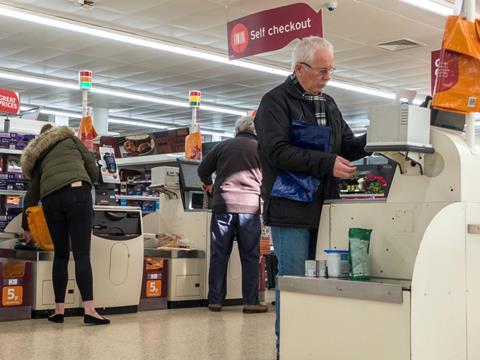
An eye-watering £3.2bn worth of goods is stolen through self-scan checkouts every year, according to VoucherCodesPro.co.uk. Stores with self-scanning can suffer between 30% and 70% more losses than stores without it, says specialist research organisation ECR Community Shrinkage and On-shelf Availability Group.
“There’s a huge issue surrounding the rise of self-scan checkouts,” says emeritus professor Adrian Beck. “What retailers created, in many respects, is a very blurry boundary between what might be theft and what might be error. If a member of staff says you seem to have not scanned an item, you apologise and say you thought you had scanned it.”
These “ready-made excuses” make it difficult for retailers to determine whether a person is a thief or not, adds Beck. “They have to prove a person has gone out with the intention to steal and that’s difficult for retailers to do.”
Celebrity chef Antony Worrall Thompson was arrested in 2012 for shoplifting from a Tesco store, but only after staff had filmed him failing to pay for goods at a self-scan checkout on five different occasions. They became suspicious and installed a hidden camera to be sure it was intentional theft.
Worrall Thompson might seem an unlikely suspect, but the rise of self-scan checkouts are creating a “new type of shoplifter”, says the University of London’s Emmeline Taylor. “Individuals who wouldn’t dream of shoplifting by any other means are now seeing this as an avenue for dishonest behaviour. Customers feel they have a certain amount of impunity when they use these systems.”
Taylor calls them “swipers”. One of their key techniques, she says, is scanning through a more expensive item as a cheaper product.
One Australian woman made global headlines after sticking photocopies of the barcode for 65-cent noodles on to more expensive items, and scanning these through the self-serve tills. She was accused of stealing £2,760 worth of groceries and given a suspended sentence of nine months in prison.
This balancing act applies to the whole store. James is now looking to refit a number of stores with security foremost in mind. That includes “ensuring there are pinch points where customers need to go past a member of the team or a security device to exit”.
“It’s gotten to a point now where the extra sales you can get through maximising your footfall by the flow of the store have to be weighed up against how much of your profit margin you are losing through theft.”
James calls it “defensive merchandising”. On “particularly vulnerable” gondola ends, for example, he will be “ensuring there are enough high-value items on the shelf but not a massive amount” to reduce the number that can be swiped in one go.
He has also hired two store detectives for one particular site where he says it became “quite obvious we were being targeted”. Within five days, the store detectives had caught 30 shoplifters, six of whom had knives. Over a six-week period, however, the numbers began to drop “as word got out” and in total they caught 103. “I don’t ever want the team to put themselves in danger, whereas two trained store detectives knew what to do. And it gave the team comfort that when we knew the problem was escalating we dealt with it swiftly by bringing in professionals.”
Iceland currently uses uniformed officers, equipped with body-worn cameras, in almost a third of stores “primarily to ensure the protection of our colleagues and customers”. An Iceland trial using plain-clothed store detectives across the country found they only added real value within the M25, where the population is more transient and less community-based. In other areas, intelligence about the employment of detectives was shared very rapidly after the first arrest,” adds Miles.
Tagging has also proven ineffective. “Applying the tags is time-consuming and responding to the activation puts colleagues at risk.”
Instead the retailer is trialling “anti-flow tagging” which “alerts store colleagues when a person is heading the wrong way down the first aisle towards the exit, the route taken in much of our shop theft. The alert enables colleagues to intervene before the shoplifter has left the premises.”
Lobbying
Initial results are “encouraging”, but there remains a lot of trial and error in any prevention method. It’s why trade bodies such as the ACS remain intent on getting the police to pick up more of the slack. In fact, they’re urging retailers to write to their local police and crime commissioners.
“They’re responsible for holding their local forces to account on all types of crime,” says Lowman. “When we looked at every PCC’s plan for their area, only one in four even mentioned business crime. By writing to their local PCC and asking them to sign the ACS’s pledge on shop theft, we hope more forces will take shop theft seriously.”
Crime prevention minister Victoria Atkins is also urging government to ensure that a plan for tackling shop theft is included in their work to deal with violent crime. The MP has set out a number of commitments, including a call for evidence so the government fully understands the scale of the problem, as well as funding for the sector to raise awareness of existing legislation. Atkins has also committed to refreshing the work of the National Retail Crime Steering Group on violent crime.
Violence is the biggest concern when it comes to theft, says Martin, and they are pressing for an amendment of the Offensive Weapons Bills along with Labour politicians David Hanson and Louise Haigh. The amendment, Martin says, “would significantly strengthen the legal protections of retail colleagues who are attacked and assaulted” by making it an offence to threaten or act violently towards staff challenging the sale of corrosive substances and knives.
As Martin points out “the punishment should fit the crime”. But all too often at the moment it feels like shop theft isn’t being treated with the gravity it deserves.
The latest in loss prevention technology
Conspicuous CCTV

Customers might not usually notice the subtle cameras placed around stores, but this isn’t the case in Sainsbury’s. At least, not if you’re using the self-service tills. The supermarket has installed CCTV cameras and mirrors above these checkouts in 300 of its stores to deter customers from failing to scan goods. A spokeswoman said they were part of a “security measure” to help increase safety at its stores. The retailer has also installed live CCTV screens above the alcohol aisle in its Selly Oak store (pictured).
Headsets

The Co-op has put in place a number of security measures in its stores, one of the most talked-about being the staff headsets. A spokesman said “they ensure instant communication with our central security team as well as each other, and feedback is extremely positive”. He added that the Co-op has spent £70m since 2015 in an attempt to protect its colleagues from violent incidents. Security improvements include security guards, additional training and “hi-tech CCTV” to help identify offenders.
Artificial intelligence

Taking loss prevention technology one step further, Australian startup black.ai has developed a platform which uses 3D sensors to maintain a ‘virtual cart’ of items for each customer. The artificial intelligence platform detects the products a customer has picked up and put back, including fresh produce. It can even determine whether a shopper has placed a Granny Smith or a Pink Lady in their basket, and can figure out whether a customer is attempting to trick a self-scan checkout.
Facial recognition
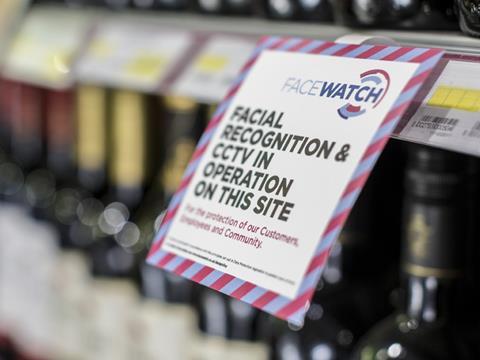
Facial recognition technology might not be new, says Nick Fisher, but his company Facewatch has commoditised it, bringing it down to “the price of a good quality CCTV system”. “Facewatch is a growing database of people for which there is evidence of committing an unlawful act. We use facial recognition to alert the business or security team within three seconds of one of those subjects of interest entering the store. It’s then for the business to determine their security protocol.”
Body worn cameras
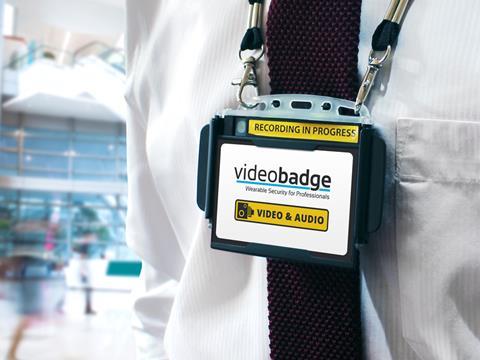
Edesix’s body worn cameras are being used by Asda to prevent theft and catch perpetrators, it claims. Following a successful trial, Asda has now rolled out the tech to over 250 of its sites and has reportedly secured “numerous convictions relating to theft and violence against staff”. There are now 900 Edesix Video Badges in operation by the retailer. Richie McBride, managing director of Edesix, says the cameras “act as a confrontation preventor” and “greatly speed up the handling of incidents”.








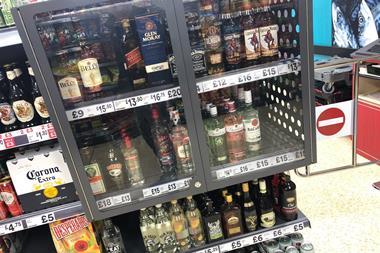




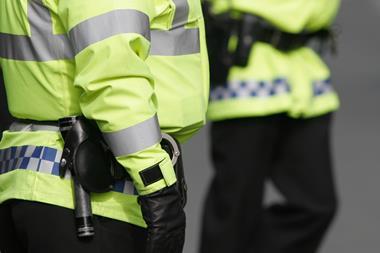






No comments yet